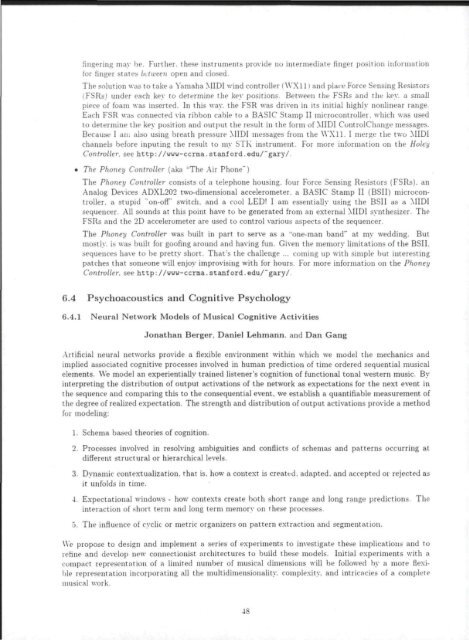Download - CCRMA - Stanford University
Download - CCRMA - Stanford University
Download - CCRMA - Stanford University
You also want an ePaper? Increase the reach of your titles
YUMPU automatically turns print PDFs into web optimized ePapers that Google loves.
fingering may be. Further, these instruments provide no intermediate finger position information<br />
for ringer states bUween open and closed.<br />
The solution was to take a Yamaha MIDI wind controller fW'Xl 11 and place Force Sensing Resistors<br />
iFSRs) under each key to determine the key positions. Between the FSRs and the key. a small<br />
piece of foam was inserted. In this way. the FSR was driven in its initial highly nonlinear range.<br />
Each FSR was connected via ribbon cable to a BASIC Stamp II microcontroller, which was used<br />
to determine the key position and output the result in the form of MIDI ControlChange messages.<br />
Because I an; also using breath pressure MIDI messages from the WXll. I merge the two MIDI<br />
channels before inputing the result to my STK instrument. For more information on the Holey<br />
Controller, see http: //www-cenna. <strong>Stanford</strong>. edu/~gary/<br />
• The Phoney Controller (aka "The Air Phone")<br />
The Phoney Controller consists of a telephone housing, four Force Sensing Resistors (FSRs). an<br />
Analog Devices ADXL202 two-dimensional accelerometer. a BASIC Stamp II (BSII) microcontroller,<br />
a stupid "on-off" switch, and a cool LED! I am essentially using the BSII as a MIDI<br />
sequencer. All sounds at this point have to be generated from an external MIDI synthesizer. The<br />
FSRs and the 2D accelerometer are used to control various aspects of the sequencer.<br />
The Phoney Controller was built in part to serve as a "one-man band" at my wedding. But<br />
mostly, is was built for goofing around and having fun. Given the memory limitations of the BSII.<br />
sequences have to be pretty short. That's the challenge ... coming up with simple but interesting<br />
patches that someone will enjoy improvising with for hours. For more information on the Phoney<br />
Controller, see http://www-ccrma.stanford.edu/~gary/<br />
6.4 Psychoacoustics and Cognitive Psychology<br />
6.4.1 Neural Network Models of Musical Cognitive Activities<br />
Jonathan Berger. Daniel Lehmann. and Dan Gang<br />
Artificial neural networks provide a flexible environment within which we model the mechanics and<br />
implied associated cognitive processes involved in human prediction of time ordered sequential musical<br />
elements. We model an experientially trained listener's cognition of functional tonal western music. By<br />
interpreting the distribution of output activations of the network as expectations for the next event in<br />
the sequence and comparing this to the consequential event, we establish a quantifiable measurement of<br />
the degree of realized expectation. The strength and distribution of output activations provide a method<br />
for modeling:<br />
1. Schema based theories of cognition.<br />
2. Processes involved in resolving ambiguities and conflicts of schemas and patterns occurring at<br />
different structural or hierarchical levels.<br />
3. Dynamic contextualization. that is. how a context is created, adapted, and accepted or rejected as<br />
it unfolds in time.<br />
4. Expectational windows - how contexts create both short range and long range predictions. The<br />
interaction of short term and long term memorv on these processes.<br />
5. The influence of cyclic or metric organizers on pattern extraction and segmentation.<br />
We propose to design and implement a series of experiments to investigate these implications and to<br />
lerine and develop new connectionist architectures to build these models. Initial experiments with a<br />
compact representation of a limited number of musical dimensions will be followed by a more flexible<br />
representation incorporating all the multidimensionality. complexitv. and intricacies of a complete<br />
musical work.<br />
4-

















